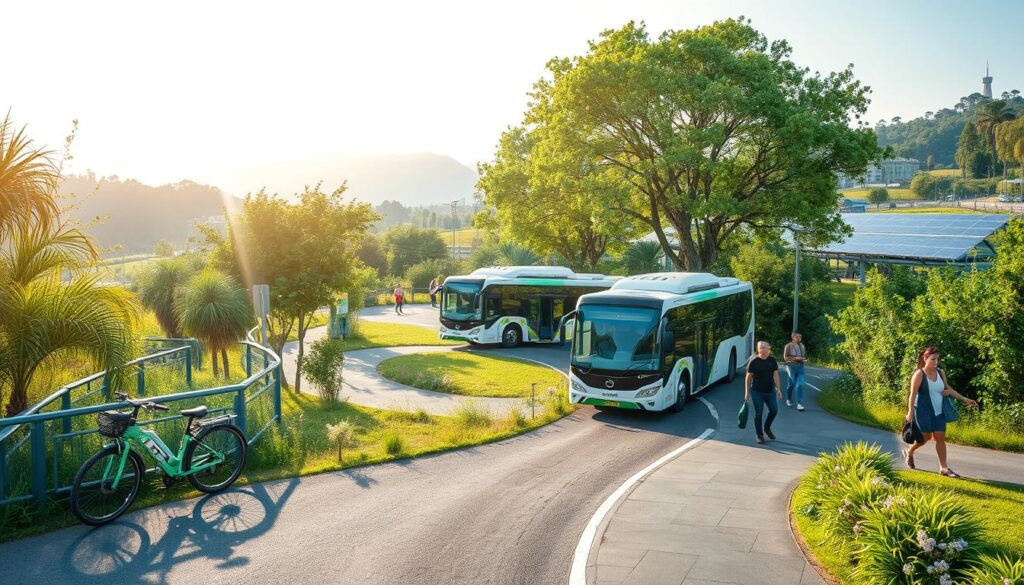Eco-friendly travel is gaining popularity as people become more environmentally aware. Travelers now seek sustainable tourism options to reduce their environmental impact. Let’s explore eco-friendly travel principles and practical tips for planning a responsible trip.
These ideas will help you create a fulfilling journey that respects our planet. By following them, you can enjoy your travels while supporting local communities and preserving nature.
Key Takeaways
- Understand the concept of eco-friendly travel and its benefits for the environment and local communities.
- Discover eco-friendly travel planning tips to reduce your carbon footprint and support sustainable tourism.
- Learn about choosing accommodations, transportation, and activities that align with your green values.
- Explore nature responsibly and minimize your impact on the destinations you visit.
- Prepare for your eco-trip by packing mindfully and adopting sustainable practices during your travels.
What is Eco-Friendly Travel?
Eco-friendly travel aims to reduce tourism’s negative impact on the environment and society. It focuses on lowering carbon footprints and supporting local economies. This approach helps preserve natural and cultural resources for future generations.
By choosing sustainable tourism, travelers can make a positive difference. They contribute to the long-term health of the places they visit.
Understanding the Concept
The core principles of eco-friendly travel include:
- Minimizing energy and resource consumption
- Reducing waste and promoting recycling
- Protecting and preserving natural habitats and wildlife
- Supporting local communities and economies
- Educating travelers on sustainable practices
Benefits of Sustainable Tourism
Eco-friendly travel practices benefit both the environment and local communities. Here are some key advantages:
- Environmental Conservation: It reduces carbon footprints and protects natural resources. This keeps destinations beautiful for years to come.
- Economic Support: Sustainable tourism creates jobs for locals. It empowers communities and promotes fair development.
- Cultural Preservation: Eco-tourism helps maintain cultural heritage and traditions. Travelers can enjoy and appreciate a destination’s unique identity.
Eco-friendly travel offers a richer, more meaningful experience. It allows you to explore while caring for the places you visit.
By choosing sustainable options, you become part of the solution. You help create a better future for both travelers and destinations.
“Sustainable tourism is not just about being eco-friendly, but about preserving the delicate balance between the environment, local communities, and the travel industry.” – Jane Doe, Sustainable Tourism Expert
Eco-Friendly Travel Planning Tips
Eco-friendly trips need careful planning. With some research, you can enjoy a sustainable and rewarding journey. Here are practical tips for greener travel:
Choose destinations that prioritize sustainable tourism. Learn about local cultures to be a respectful traveler. Plan your transportation to reduce your carbon footprint.
- Choose your destination wisely. Opt for destinations that prioritize sustainable tourism and have a strong commitment to environmental protection.
- Investigate the local culture and customs. Learning about the cultural traditions and values of your destination can help you be a more respectful and mindful traveler.
- Plan your transportation carefully. Consider modes of travel that have a lower carbon footprint, such as trains, buses, or electric vehicles.
- Book eco-friendly accommodations. Look for hotels, lodges, or campsites that incorporate sustainable practices and minimize their impact on the environment.
- Research eco-friendly activities and attractions. Seek out experiences that allow you to explore and appreciate nature while minimizing your carbon footprint.
- Pack thoughtfully and reduce waste. Bring reusable items, such as water bottles, utensils, and bags, to minimize your use of single-use plastics.
These eco-friendly travel planning tips lead to a sustainable travel experience. Your trip can be fun and environmentally conscious.
| Eco-Friendly Travel Planning Checklist |
|---|
|

“Responsible tourism is not just about protecting the environment, but also about respecting the local culture and empowering the community.” – Jane Doe, Sustainable Travel Expert
Choosing Sustainable Accommodations
Picking eco-friendly places to stay is key for green travelers. Many options exist to enjoy trips while supporting earth-friendly businesses. These include eco-lodges, green hotels, camping, and glamping.
Eco-Lodges and Green Hotels
Eco-lodges and green hotels lead in sustainable lodging. They focus on energy-saving practices, renewable resources, and waste reduction. Look for certifications like LEED, Green Seal, or Eco-Label when choosing.
These labels show a strong commitment to protecting the environment. They can help you find truly eco-friendly places to stay.
Camping and Glamping Options
Green camping lets you connect with nature while reducing your carbon footprint. Glamping offers luxury camping with eco-friendly features and design. Both use renewable energy and encourage low-impact activities.
These options often compost waste to preserve the surrounding area. They provide a more immersive eco-friendly experience for travelers.
Choosing environmentally conscious lodging supports sustainable tourism growth. It allows you to enjoy a guilt-free getaway. Research is key to planning a green travel experience.

“Sustainable travel is not just about reducing our impact, but also about supporting businesses that prioritize environmental and social responsibility.”
Eco-friendly travel Transportation
Your travel choices can greatly impact your carbon footprint. Sustainable options are plentiful and diverse. Let’s explore ways to minimize your environmental impact while traveling.
Reducing Your Carbon Footprint
Eco-friendly transportation is key to lowering your carbon footprint. Here are some sustainable options:
- Using public transit, such as buses, trains, or subways, whenever possible
- Renting or using electric or hybrid vehicles
- Exploring bike-sharing or walking opportunities in your destination
- Offsetting your carbon emissions by purchasing carbon credits or supporting carbon-neutral initiatives
These sustainable choices can significantly reduce your environmental impact. They also contribute to a greener future for all.
| Transportation Option | Environmental Impact | Accessibility |
|---|---|---|
| Public Transit | Low carbon emissions | Widely available in most urban areas |
| Electric/Hybrid Vehicles | Zero direct emissions | Increasing availability, though charging infrastructure may be limited in some regions |
| Bicycling/Walking | Zero emissions | Dependent on destination’s infrastructure and terrain |
| Carbon Offsets | Neutral emissions | Widely available through various providers |
Incorporating these eco-friendly options into your travels can make a difference. You’ll reduce your carbon footprint and support a sustainable future.

Sustainable Activities and Attractions
Choose activities that match your sustainability values for your eco-friendly trip. Explore nature responsibly to appreciate the world’s beauty. This approach minimizes your impact on the environment.
Exploring Nature Responsibly
Sustainable tourism activities like hiking and kayaking offer immersive outdoor experiences. These nature-based experiences connect you with the environment. They also support local communities and conservation efforts.
- Opt for guided eco-tours or self-guided trails that educate visitors on the local ecosystem and promote environmentally conscious travel experiences.
- Stick to designated paths and trails to avoid disrupting fragile habitats or damaging sensitive landscapes.
- Pack out all your trash and leave no trace to maintain the pristine condition of the areas you visit.
Eco-friendly attractions like nature reserves and wildlife sanctuaries offer unique experiences. These destinations support sustainable tourism activities. By visiting them, you help preserve ecosystems and support local communities.
“Responsible travel means taking the time to understand and respect the places and people you visit, and making a positive impact through your choices and actions.”
Be mindful of your impact when exploring nature. Strive to leave a minimal footprint. Engaging in responsible outdoor recreation helps preserve the world’s beauty.
Packing and Preparing for Your Eco-Trip
Eco-friendly journeys require thoughtful packing and planning. Choose only essential items to reduce your carbon footprint. Use sustainable gear like reusable water bottles and eco-friendly clothing to minimize waste.
Evaluate each item’s necessity when packing for your eco-trip. Pick versatile garments that can be mixed and matched. This approach lightens your load and supports sustainable travel principles.
Pack reusable items like cloth bags, straws, and utensils. This simple step can greatly reduce your environmental impact. Green travel preparations set the stage for an unforgettable, sustainable adventure.











